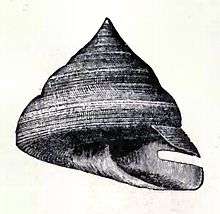Perotrochus quoyanus
Perotrochus quoyanus is a species of large sea snail, a marine gastropod mollusk in the family Pleurotomariidae, the slit snails.[2][3]
- Subspecies
- Perotrochus quoyanus insularis Okutani & Goto, 1985 (synonym: Perotrochus insularis Okutani & Goto, 1985 )
- Perotrochus quoyanus quoyanus (P. Fischer & Bernardi, 1856) (synonyms: Pleurotomaria quoyana Fischer & Bernardi, 1856; Perotrochus gemma F. M. Bayer, 1966; Perotrochus coltrorum Rios, 2003)
| Perotrochus quoyanus | |
|---|---|
 | |
| Drawing with an apertural view of a shell of Perotrochus quoyanus | |
| Scientific classification | |
| Kingdom: | Animalia |
| Phylum: | Mollusca |
| Class: | Gastropoda |
| Clade: | Vetigastropoda |
| Superfamily: | Pleurotomarioidea |
| Family: | Pleurotomariidae |
| Genus: | Perotrochus |
| Species: | P. quoyanus |
| Binomial name | |
| Perotrochus quoyanus | |
Description
The shell of Perotrochus quoyanus quoyanus has a trochiform shape. It is obtusely carinated, with the base rounded, flattened and concave but not umbilicated. The spire is turbinate, terminating in an acuminate apex. The nine, granulose whorls are slowly increasing. They are rounded and swollen toward the suture. They are divided into two unequal portions by the slit fasciole. The slit fascicle below the middle is decussated by semicircular and spiral striae. The slit is quite wide, but short. The umbilical depression is excavated, nacreous, iridescent, and surrounded by slight concentric grooves. The semioval aperture is nacreous within. The columellar margin is recurved with a nacreous callosity. The nearly sharp outer lip is not reflexed. The color of the shell is pale rose, with obscure dashes or flammules of reddish brown. [4]
Distribution
This species occurs in the Caribbean Sea and the Lesser Antilles.
Fresh-dead (crabbed) shells have been trapped offshore West coast BARBADOS, at depths around 180-200 metres.
Living specimens were recovered during the late 1980s, via Johnson Sea-Link II submersible, operating from R.V. Seward Johnson of Harbor Branch Oceanographic Institute at greater depths, 2-3 miles offshore West coast Barbados.
References
- Fischer & Bernardi, Journ. de Conchyl. v, p. 165, t. 5, f.1-3, 1856
- Bouchet, P.; Rosenberg, G. (2012). Perotrochus quoyanus (P. Fischer & Bernardi, 1856). Accessed through: World Register of Marine Species at http://www.marinespecies.org/aphia.php?p=taxdetails&id=467973 on 2013-02-16
- Turgeon, D.D., et al. 1998. Common and scientific names of aquatic invertebrates of the United States and Canada. American Fisheries Society Special Publication 26
- G.W. Tryon (1890), Manual of Conchology vol. XII, p. 69